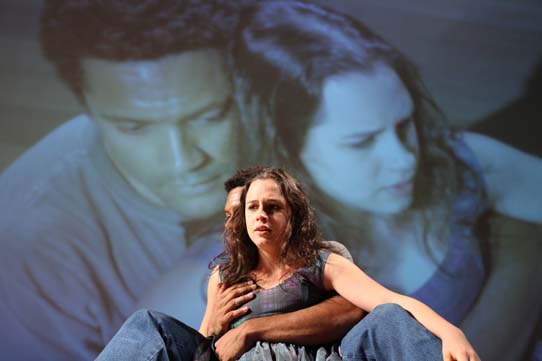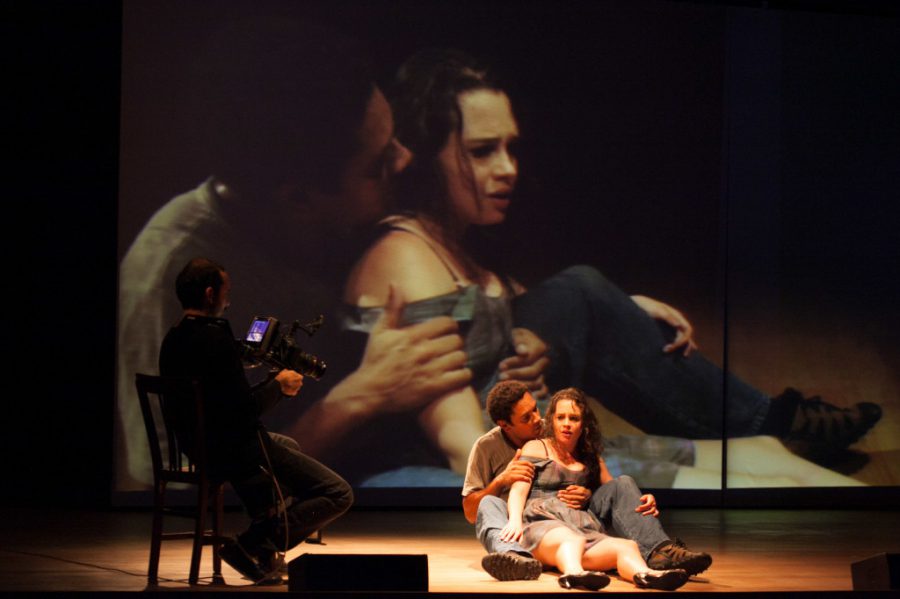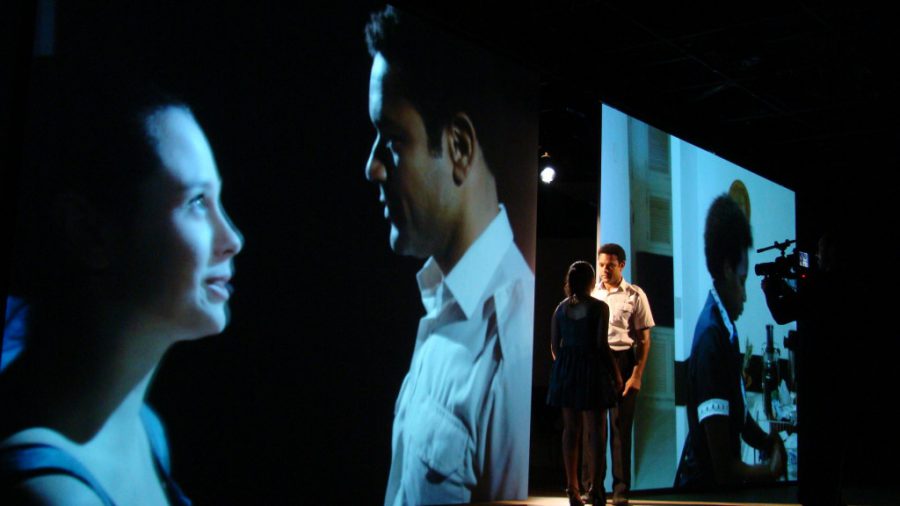Julia
2011
With the assemble of Julia begins a new trilogy, which starts from classical texts for the dramaturgical construction and investigates the integration of theater and cinema on the scene. In previous works, the artistic proposition was to transform a material that departed from reality into a fictional material. From Julia, the question becomes “introjecting” the “reality” into a preexisting fiction; in this case, the text Miss Julia, by August Strindberg.
In Julia, the theater is integrated live and the cinematographic structures are exposed. With pre-filmed footage and live footage, the film is built in the presence of the public every day. The actors make a movie and at the same time act as the characters of fiction. The setting consists of split movie screens, which move during the action, revealing parts of a bedroom and a kitchen, sets for live footage. The projectors follow the movement of the screens, creating a movie in motion. At the beginning of the play, some scenes being shot and projected simultaneously are seen through the gaps of the panels by different parts of the audience, but as the action progresses the panels flip open what was behind the screens, in a direct analogy with what is happening with the characters / actors themselves.
This is the first work that integrates video projection and camera to the scene. The video projection and the presence of the cameraman are deeply linked to the dramaturgical construction. There are pre-shot scenes, which were shot in real locations, and timed footage shot simultaneously. The film is assembled in real time, and as in a film set, it is cut and redone sometimes, in multiple takes, either through the command of “action” and “cuts” of the cameraman, or by the relation of the actors, by becoming more extreme, it breaks “fiction”, generating new interpretive layers. Like the “fractures” existing in acting and space, the movie screen is also split, sometimes composing a large screen of 16:9 and in others forming two screens of 4:3, with different and simultaneous video projections. The various layers – space, acting, the junction of the theater with the cinema – in their overlaps converge to create a third and only zone, which reveals the structures of the scene, the cinema and also the actors / characters.
For this work was necessary to find a performance that “fit” in both media simultaneously, without losing the restraint revealed in the approaches of the camera and the explosions that “break” the screen and flood the theater. The real time of the scene, the parts of the bodies in motion leaking through the cracks of the scene, added to the big screen of cinema that shows the details provoke a visceral reality that goes to meet the concept of the assembly, transforming in image and action the content of the piece , which brings the conflict to Brazil today. If Strindberg put a magnifying glass in the relationship of two beings so different and close in the nineteenth century, here, through the camera, the permanent presence and testimony invade and build together with the audience the scenic and filmic events.
Premiered at the Sesc Copacabana Space in Rio de Janeiro in November 2011 and at Sesc Belenzinho in São Paulo in October 2012. Winner of the Shell Best Director Award in 2012.
Festivals and international venues : Kunstenfestivaldesarts (Bruxelas/Bélgica), Wiener Festwochen (Viena/Áustria), Zurcher Theaterspektakel (Zurique/Suíça), Noordezon Performing Arts Festival (Grooening/Holanda), Temps d’Image (Le CentQuatre – Paris/França), Festival de Keuze (Roterdã/Holanda), Künstlerhaus Mousonturm (Frankfurt/Alemanha), Festival Temporada Alta (Girona/Espanha), Centro Dramático Nacional (Madri/Espanha), REDCAT (Los Angeles/EUA ), On the Boards (Seattle/EUA ), Teatro Piccolo Arsenale – Bienal de Veneza – Veneza/Itália), Théâtre La Rose des Vents (Lille/França), Teatro Maria Matos (Lisboa/Portugal), Festival Le Batiê (Genebra/Suíça), Festival Um alles in Der Welt – Die Lessingtage – Thalia Theater Gauss (Hamburgo/Alemanha), Bonlieu Scène Nationale (Annecy/França), Le Carré des Jalles (Saint-Médard-en Jalles/França), Théâtre d’Hérouville-Saint-Clair (Caen/França), Espace des Arts Scène Nationale (Chalon-sur-Saône/França), Lieu Unique (Nantes/ França), Espaces pluriels (Pau/França), Teatre Jarazca ‒ Nowa Klasyka Europy Festival (Lodz/Polônia), Centre National Dramatique de Haute-Normandie (Rouen/França), Théâtre Populaire Romand (La Chaux-de-Fonds/Suíça), MITsp Festival Internacional São Paulo (SP/Brasil), Festival Porto Alegre em Cena (RS/ Brasil), FIAC Salvador (BA/Brasil), Festival de Teatro de Recife (PE/Brasil), Festival de Curitiba (PR/Brasil), Galpão Cine-Horto (Belo Horizonte/Brasil).
–
JULIA
By Christiane Jatahy
Based on the text Miss Julie by August Strindberg
Design, Direction and Adaptation CHRISTIANE JATAHY
With Julia Bernat and Rodrigo Odê
Stage design conception Christiane Jatahy and Marcelo Lipiani
Stage design direction Marcelo Lipiani
Photography and movie camera David Pacheco
Live camera Paulo Camacho
Lighting design Renato Machado and David Pacheco
Costumes Angele Frós
Soundtrack Rodrigo Marçal
Body training Dani Lima
Video system Julio Parente
Video Operator Francesca Berselli
Lighting and sounding Operator Leandro Barreto
Stage Manager Thiago Katona
Movie cast Tatiana Tiburcio
Production and tour manager Claudia Marques and Henrique Mariano
The tour is supported by the CENTQUATRE on the road
Video
Gallery
Past dates
- 29 MAR › 01 APR 2023
- Théâtre de Namur, Belgique
Press review
Conflitto di classe alla Biennale Teatro A Venezia uno Strindberg brasiliano
Awards and Reviews
JULIA
Shell AWARD for Best Director in 2012.
“Tout ici est organisé de façon à ce que le spectateur écoute, comprenne, se pose des questions et, d’une certaine manière, se dépasse, dans une démarche de résilience.A ce théâtre, on peut opposer, et, ô combien !, préférer celui de la perturbation proposé par Christiane Jatahy, qui ne cherche pas à réparer les vivants. Au contraire : illes montre cabossés, questionnés, déchirés, à travers un saisissant portrait de femme, inspire par Mademoiselle Julie. Julie. Devenue Julia, la pièce d’August Strindberg (1849-1912) s’inscrit dans le Brésil d’aujourd’hui et nous montre à quel point les traces de l’esclavage imprègnent encore souterrainement la société.”
Brigitte Salino – Le Monde, 05/09/2014 (France)
“Si elle conserve la situation, si elle suit à peu près la trame, elle se distingue de la pudeur de l’écrivain (la pièce date de1888) et demande aux deux interprètes principaux un engagement physique terrible dans une scène de sexe et dans une scène d’humiliation verbale qui sont paroxistiques”
Armelie Heliot – Le Figaro, 09/11/2014 (France)
“La mise en scène brouille toutes les frontières, entre l’écran et la scène, entre le social et l’individuel, entre la représentation et l’imprévu. Les états d’âme que les acteurs adressent au public en français, la présence insistante du cadreur et de la régie, un selfie avec le caméraman que Julia poste sur Facebook, produisent un ensemble incertain dans lequel l’événement vraiment imprévu ne dénote pas. (…) La polarité qui organise la pièce, entre séquences enregistrées et jouées, se transforme en conflit ouvert quand l’écran impose son dernier mot alors que Julia avait promis une fin ouverte aux spectateurs.”
Nicolas Garnier – Ma Culture, 11/07/2014 (France)
–
Essay
Julia between two worlds
March 20th, 2012 Carlos Alberto Mattos – film critic – RJ
Julia, the play-movie that gave the Award for best Director to Christiane Jatahy can be seen over the next two weekends at Studio Sergio Porto. it’s one of the best things there is to see in the city. Adapting the play Strindberg’s Miss Julia for a Brazilian ambiance, the spectacle condenses an entirely contemporary discussion about cinema and theater… Christiane is the most interesting artist of the moment in this field: the mix between theatre and cinema.
Perhaps what interest me and seduce me most is not what happens in the cinema “or” in the theatre. The great thing about Julia is precisely what happens in the middle between one expression and another. And this is possible only when both expressions of truth coexist. Julia is far beyond the habitual use of multimedia projections in theatrical productions. I have seen many beautiful and expressive resources in this area, but Julia touches the nerve of the issue. Our attention and delight are attracted to something that is not good cinema, nor is it good theater, but bridges between the two…Julia is exceptional because it touches something that is essential in contemporary perception. When the ‘Real’ and the ‘Virtual’ are in communication they intensify each other and generate one “third thing”.
“Belle découverte au KFDA. «Julia», une «Mlle Julie» brésilienne. Contemporaine et percutante.
“Double révélation pour cette «Julia » brésilienne : une réalisatrice, Christiane Jatahy, qui se joue habilement des codes du cinéma, de la vidéo de plateau et du théâtre. Et des acteurs qui «déchirent» l’écran et existent sur le plateau” Christian Jade – RTBF.be
“With JULIA, Christiane Jatahy Kunstenfestivaldesarts introduces the new voice of Brazilian theater. Julia is innovative theater with a strong cinematic impact. Must see” Le Libre ( Kusntenfestivaldesarts – Brussels)
“Das Publikum dankt für diesen überraschenden, klugen, nachdenklich und doch irgendwie fröhlich stimmenden Abend mit Riesenapplaus. Der kurze, aber heftige Parforceritt der Darsteller war ein Erfolg” Von Michaela Mottingers-Meinung
“Ici la folie rime avec le génie. Dépassez les frontières des idées préconçues et ouvrez les yeux vers un spectacle qui va vous saisir et marquer votre esprit.” Julia, une femme bouleversante 22h05 rue des Dames
“Christiane Jatahy vient du cinéma (elle a réalisé en treize heures et trois caméras un film qui, une fois monté, fait pile treize heures !) et aime travailler sur les frontières, le borderline. « Julia » est son premier spectacle à venir en France. On en redemande.” Jean-Pierre Thibaudat – Rue89
“A wonderful and consistent work of a director in permanent movement” Macksen Luiz – theater critics
”Julia” updates a classic text with singularity and pungency, besides exploring new narrative possibilities in theater.”Luis Fernando Ramos – theater critics – Folha de São Paulo







